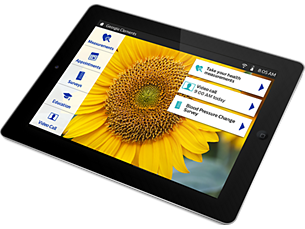- Behavioral science foundation¹ || eTrAC
-
Behavioral science foundation¹
Extensive research on patient lifestyle and communication habits; and input from behavioral scientists on patient motivations and health behaviors enable are built into the eTRAC program, enabling personalized subject-matter and effective, confidence-boosting self-care strategies. - Clinical support || eTrAC
-
Clinical support
The eTrAC program includes patient selection criteria definition; patient stratification tools, including surveys on medication compliance, nutrition and depression; and reporting for program administrators and physicians. - Patient education || eTrAC
-
Patient education
Audiovisual patient education programs leverage video and tablet technology to increase health literacy for patient populations. The use of less technical language combined with an interactive approach helps improve patient knowledge, self-care abilities and confidence; which can lead to behavioral changes that make a difference in health and quality of life. - Technology-powered communication || eTrAC
-
Technology-powered communication
Using two-way live video, clinicians can connect with and assess patients more accurately. This face-to-face interaction is designed to foster care plan compliance and help enhance diagnosis by providing immediate access to patient feedback. In addition, two-way video is designed to build patient self-care skill. - Training || eTrAC
-
Training
The eTrAC program includes comprehensive training and support resources, including online CEU courses; clinical staff education and training on telehealth devices, software and protocols; patient education; and a Telehealth Certification Program to credential your clinical staff. - Implementation services || eTrAC
-
Implementation services
Our multi-disciplinary team of clinical and technical professionals delivers a range of services for program design and resource planning.
Behavioral science foundation¹
Behavioral science foundation¹
Clinical support
Clinical support
Patient education
Patient education
Technology-powered communication
Technology-powered communication
Training
Training
Implementation services
Implementation services
- Program features and services || eTrAC
- Behavioral science foundation¹ || eTrAC
- Clinical support || eTrAC
- Patient education || eTrAC
- Behavioral science foundation¹ || eTrAC
-
Behavioral science foundation¹
Extensive research on patient lifestyle and communication habits; and input from behavioral scientists on patient motivations and health behaviors enable are built into the eTRAC program, enabling personalized subject-matter and effective, confidence-boosting self-care strategies. - Clinical support || eTrAC
-
Clinical support
The eTrAC program includes patient selection criteria definition; patient stratification tools, including surveys on medication compliance, nutrition and depression; and reporting for program administrators and physicians. - Patient education || eTrAC
-
Patient education
Audiovisual patient education programs leverage video and tablet technology to increase health literacy for patient populations. The use of less technical language combined with an interactive approach helps improve patient knowledge, self-care abilities and confidence; which can lead to behavioral changes that make a difference in health and quality of life. - Technology-powered communication || eTrAC
-
Technology-powered communication
Using two-way live video, clinicians can connect with and assess patients more accurately. This face-to-face interaction is designed to foster care plan compliance and help enhance diagnosis by providing immediate access to patient feedback. In addition, two-way video is designed to build patient self-care skill. - Training || eTrAC
-
Training
The eTrAC program includes comprehensive training and support resources, including online CEU courses; clinical staff education and training on telehealth devices, software and protocols; patient education; and a Telehealth Certification Program to credential your clinical staff. - Implementation services || eTrAC
-
Implementation services
Our multi-disciplinary team of clinical and technical professionals delivers a range of services for program design and resource planning.
Behavioral science foundation¹
Behavioral science foundation¹
Clinical support
Clinical support
Patient education
Patient education
Technology-powered communication
Technology-powered communication
Training
Training
Implementation services
Implementation services
Documentation
-
Brochure (1)
Related products
Alternative products
-
eCareCoordinator
- Patient and population management
- Patient communication and engagement
- Connected care and collaboration across the enterprise
- Empower patients to self-care
View product
-
eCareCompanion patient app
- Easy to use and intuitive
- Wireless connection
- Vital trends
- Glucose meters compatibility
View product
- 1. Debra Lieberman, Ph.D., Consultant, Evidence-Based Strategies for Improving Home Telehealth Educational Videos Users’ Health Behaviors,(2015)
- 2. Ryan Spaulding, PhD , Medicaid HCBS/FE Home Telehealth Pilot, Center for Telemedicine & Telehealth University of Kansas Medical Center November 30, 2010


